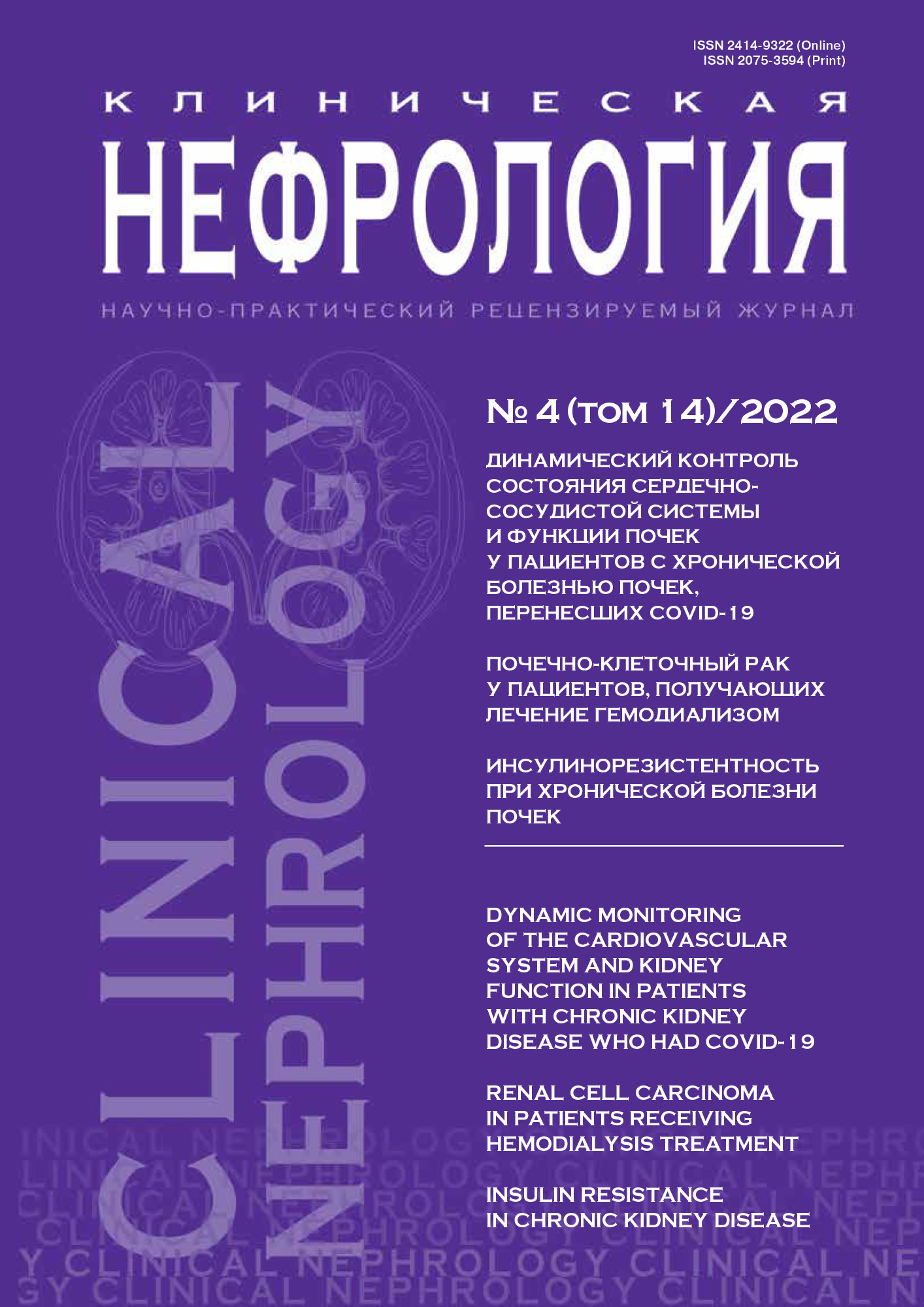Почечно-клеточный рак у пациентов, получающих лечение гемодиализом
- Авторы: Лубенников А.Е.1, Трушкин Р.Н.1, Бережная Э.Э.1, Исаев Т.К.1, Морозов Н.В.1, Медведев П.Е.1, Колесников Н.О.1
-
Учреждения:
- ГБУЗ «Городская клиническая больница № 52» ДЗМ
- Выпуск: Том 14, № 4 (2022)
- Страницы: 27-32
- Раздел: Статьи
- Статья опубликована: 15.12.2022
- URL: https://journals.eco-vector.com/2075-3594/article/view/275464
- DOI: https://doi.org/10.18565/nephrology.2022.4.27-32
- ID: 275464
Цитировать
Полный текст
Аннотация
Полный текст
Об авторах
Александр Евгеньевич Лубенников
ГБУЗ «Городская клиническая больница № 52» ДЗМ
Email: lualev@yandex.ru
д.м.н., врач-уролог урологического отделения Москва, Россия
Руслан Николаевич Трушкин
ГБУЗ «Городская клиническая больница № 52» ДЗМ
Email: uro52@mail.ru
д.м.н., заведующий урологическим отделением Москва, Россия
Эльвира Элчиновна Бережная
ГБУЗ «Городская клиническая больница № 52» ДЗМврач-патологоанатом Москва, Россия
Теймур Карибович Исаев
ГБУЗ «Городская клиническая больница № 52» ДЗМ
Email: dr.isaev@mail.ru
к.м.н., врач-уролог урологического отделения Москва, Россия
Николай Вячеславович Морозов
ГБУЗ «Городская клиническая больница № 52» ДЗМ
Email: nikmorozov@rambler.ru
врач-уролог урологического отделения Москва, Россия
Павел Евгеньевич Медведев
ГБУЗ «Городская клиническая больница № 52» ДЗМ
Email: pah95@mail.ru
врач-уролог урологического отделения Москва, Россия
Николай Олегович Колесников
ГБУЗ «Городская клиническая больница № 52» ДЗМ
Email: knikolai@list.ru
врач-уролог урологического отделения Москва, Россия
Список литературы
- Hurst F.P., Jindal R.M., Fletcher J.J., et al. Incidence, predictors and associated outcomes of renal cell carcinoma in long-term dialysis patients. Urol. 2011;77(6):1271-76. doi: 10.1016/j.urology.2011.01.007.
- Stewart J.H., Buccianti G., Agodoa L., et al. Cancers of the kidney and urinary tract in patients on dialysis for end-stage renal disease: analysis of data from the United States, Europe, and Australia and New Zealand. J. Am. Soc. Nephrol. 2003;14(1):197-207. doi: 10.1097/01.asn.0000039608.81046.81.
- Engels E.A., Pfeiffer R.M., Fraumeni J.F., et al. Spectrum of cancer risk among US solid organ transplant recipients. JAMA. 2011;306(17):1891-901. doi: 10.1001/jama.2011.1592.
- Holley J.L. Screening, diagnosis, and treatment of cancer in long-term dialysis patients. Clin. J. Am. Soc. Nephrol. 2007;2(3):604-10. Doi: 10.2215/ CJN.03931106.
- Lutz J., Menke J., Sollinger D., et al. Haemostasis in chronic kidney disease. Nephrol. Dial. Transplant. 2014;29(1):29-40. doi: 10.1093/ndt/gft209.
- Acedillo R.R., Shah M., Devereaux P.J., al. The risk of perioperative bleeding in patients with chronic kidney disease: a systematic review and meta-analysis. Ann. Surg. 2013;258(6):901-13. doi: 10.1097/SLA.0000000000000244.
- Sanli O., Tefik T., Ortac M., et al. Laparoscopic nephrectomy in patients undergoing hemodialysis treatment. JSLS. 2010;14(4):534-40. Doi: 10.4293/ 108680810X12924466008123.
- Frasca G.M., Brigante F., Volpe A., et al. Kidney transplantation in patients with previous renal cancer: a critical appraisal of current evidence and guidelines. J. Nephrol. 2019;32(1):57-64. doi: 10.1007/s40620-018-0542-y.
- Boissier R., Hevia V., Bruins H.M., et al. The Risk of Tumour Recurrence in Patients Undergoing Renal Transplantation for End-stage Renal Disease after Previous Treatment for a Urological Cancer: A Systematic Review. Eur. Urol. 2018;73(1):94-108. doi: 10.1016/j.eururo.2017.07.017.
- Cognard N., Anglicheau D., Gatault P., et al. Recurrence of Renal Cell Cancer After Renal Transplantation in a Multicenter French Cohort. Transplantat. 2018;102(5):860-67. doi: 10.1097/TP.0000000000002009.
- Bellido J.A., Palou J., Htibner M., et al. Early ultrasound detection of renal tumors in patients with end stage renal disease in dialysis. Arch. Esp. Urol. 2007;60(9):1079-83. doi: 10.4321/s0004-06142007000900004.
- Jung S.H., Han Y.J., Shin S.H., et al. Sudden Intraoperative Hyperkalemia during Laparoscopic Radical Nephrectomy in a Patient with Underlying Renal Insufficiency. Acute Crit. Care. 2018;33(4):271-75. doi: 10.4266/acc.2016.00696.
- Keehn A., Maiman R., Agalliu I., et al. Outcomes and Management Considerations in Patients on Dialysis Undergoing Laparoscopic Radical Nephrectomy for Renal-Cell Carcinoma. J. Endourol. 2015;29(6):691-95. doi: 10.1089/end.2014.0484.
- Novara G., Ficarra V., Antonelli A., et al. Corrigendum to “Validation of the 2009 TNM version in a large multi-institutional cohort of patients treated for renal cell carcinoma: Are further improvements needed?” Eur. Urol. 2010;58:588-95. doi: 10.1016/j.eururo.2010.10.017.
- Klatte T., Chung J., Leppert J.T., et al. Prognostic relevance of capsular involvement and collecting system invasion in stage I and II renal cell carcinoma. BJU.Int. 2007;99(4):821-24. doi: 10.1111/j.1464-410X.2006.06729.x.
- Wagener N., Edelmann D., Benner A., et al. Outcome of papillary versus clear cell renal cell carcinoma varies significantly in non-metastatic disease. PLoS. One. 2017;12(9):e0184173. doi: 10.1371/journal.pone.0184173.
- Cheville J.C., Lohse C.M., Zincke H., et al.Comparisons of outcome and prognostic features among histologic subtypes of renal cell carcinoma. Am. J. Surg. Pathol. 2003;27(5):612-24. doi: 10.1097/00000478-200305000 00005.
- Leibovich B.C., Lohse C.M., Crispen P.L., et al. Histological subtype is an independent predictor of outcome for patients with renal cell carcinoma. J. Urol. 2010;183(4):1309-15. doi: 10.1016/j.juro.2009.12.035.
- Moch H., Cubilla A.L., Humphrey P.A., et al. The 2016 WHO Classification of Tumours of the Urinary System and Male Genital Organs-Part A: Renal, Penile, and Testicular Tumours. Eur. Urol. 2016;70(1):93-105. doi: 10.1016/j.eururo.2016.02.029.
- Zhang B.Y., Cheville J.C., Thompson R.H., et al. Impact of Rhabdoid Differentiation on Prognosis for Patients with Grade 4 Renal Cell Carcinoma. Eur. Urol. 2015;68(1):5-7. doi: 10.1016/j.eururo.2015.01.002.
- Lang H., Lindner V., de Fromont M., et al. Multicenter determination of optimal interobserver agreement using the Fuhrman grading system for renal cell carcinoma: Assessment of 241 patients with >15-year follow-up. Cancer. 2005;103(3):625-29. doi: 10.1002/cncr.20812.
- Sorbellini M., Kattan M.W., Snyder M.E., et al. A postoperative prognostic nomogram predicting recurrence for patients with conventional clear cell renal cell carcinoma. J. Urol. 2005;173(1):48-51. doi: 10.1097/01. ju.0000148261.19532.2c.
- Patard J.J., Kim H.L., Lam J.S., et al. Use of the University of California Los Angeles integrated staging system to predict survival in renal cell carcinoma: an international multicenter study. J. Clin. Oncol. 2004;22(16):3316-22. doi: 10.1200/JCO.2004.09.104.
- Leibovich B.C., Blute M.L., Cheville J.C., et al. Prediction of progression after radical nephrectomy for patients with clear cell renal cell carcinoma: a stratification tool for prospective clinical trials. Cancer. 2003;97(7):1663-71. doi: 10.1002/cncr.11234.
Дополнительные файлы








